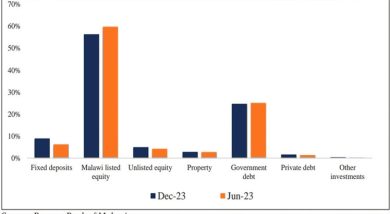Hunger ahead, so what?

Do you remember the 2001/02 Malawi food crisis which is estimated to have killed close to 1 000 people? Well, if you do not, some do and of course there are reports.
The United Nations Development Programme (UNDP) 2008/09 occasional paper on causes and consequences of famine in Malawi argues that the devastating famine first surfaced as rumours whispered in rural areas as early as October 2001, but little was done to mitigate against it.
The paper notes that the Malawi Economic Justice Network (Mejn) and the Catholic Commission for Justice and Peace (CCJP) began to present evidence supporting the reports coming from the countryside.
The paper sadly notes that consequently, between 500 and 1 000 people died of hunger or hunger-related diseases in the Southern and Central regions of the country, by the time the crisis in rural Malawi was finally publicised in February 2002.
But what caused the food crisis?
UNDP notes that the immediate cause for the food crisis included erratic rainfall—localised flooding and waterlogging of fields.
The famine Early Warning System (Fewsnet) predicted a maize shortfall of 273 000 tonnes in the farming season, but assumed households would buffer the deficit with stocks from the previous year.
Emergency response
The report further notes that the Ministry of Agriculture argued that the root and tuber production would offset the dip in maize production and provide adequate, if not surplus, food for the country.
UNDP notes that the Strategic Grain Reserve (SGR) had been sold, thereby paralysing the government’s emergency response mechanism. That is government was unable to distribute food at the necessary time.
And reliance on food imports proved futile. UNDP noted that food imports did not arrive on time due to congested roads, the diversion of food trucks to Zimbabwe and Zambia, a train derailment at Beit Bridge and capacity constraints at Nacala and Beira ports in Mozambique.
Because there was no maize available, the report notes, Malawians resorted to consuming pumpkin leaves, banana stems, even discarded sugar cane thrown on the street, reflecting the harsh reality.
Today, government says there will be severe food shortage, at least going by what President Joyce Banda has recently been saying. So what are we doing about it?
This year, based on official third round crop estimates released by the Ministry of Agriculture and Food Security , a maize surplus of 194 339 tonnes is expected after fulfilling the national requirement.
However, considering only rain-fed maize production the figures indidcate that the country has a shortage of 286 452 tonnes.
And, Fewsnet July 2013 report notes that informal traders are still exporting maize with April and June 2013 figures 39 percent higher than the five-year average.
Stock levels
Further Fewsnet notes that as of mid-July, the National Food Reserve Agency (NFRA) reported that stocks are only three percent of their targeted level of 30 000 tonnes through funding commitments from Norway and Ireland. The funding was expected to replenish 50 000 tonnes of maize, but due to current prices of more than 200 percent above last year’s, the funds pledged can only cover about 30 000 tonnes.
The Reserve Bank of Malawi (RBM) based on Monetary Policy Committee (MPC) resolutions has maintained its high base lending rate at 25 percent premised on inflationary risks and food security.
The MPC took into account developments in the global economy, latest movements in macroeconomic aggregates, as well as emerging financial market risk and the food situation in the country.
The MPC further noted that a seasonal increase in food stocks across the country—which resulted in a decline in food prices—contributed to the slowdown in inflation, although the reduction was not as marked as expected.
Malawi’s inflation peaked in February during the food lean period at 37.9 percent and has since slowed down to 31 percent in May and 27.9 percent in June.
Malawi’s inflation—calculated using the Consumer Price Index (CPI)—is largely influenced by food and non alcoholics prices which contribute 50.2 percent.
And, reports indicate that Government may resort to maize imports which will certainly put pressure on our foreign exchange and consequently weaken the kwacha.
So far RBM has accumulated official reserves up to 2.5 months equivalent of import cover, but experts have noted that an impending rise in foreign exchange demand may destabilise the situation. And that coupled with food imports may further worsen the situation, push inflation up and force the RBM to uphold interest rates.






Poorly written article minimising hunger. I can’t believe this is The Nation newspaper!